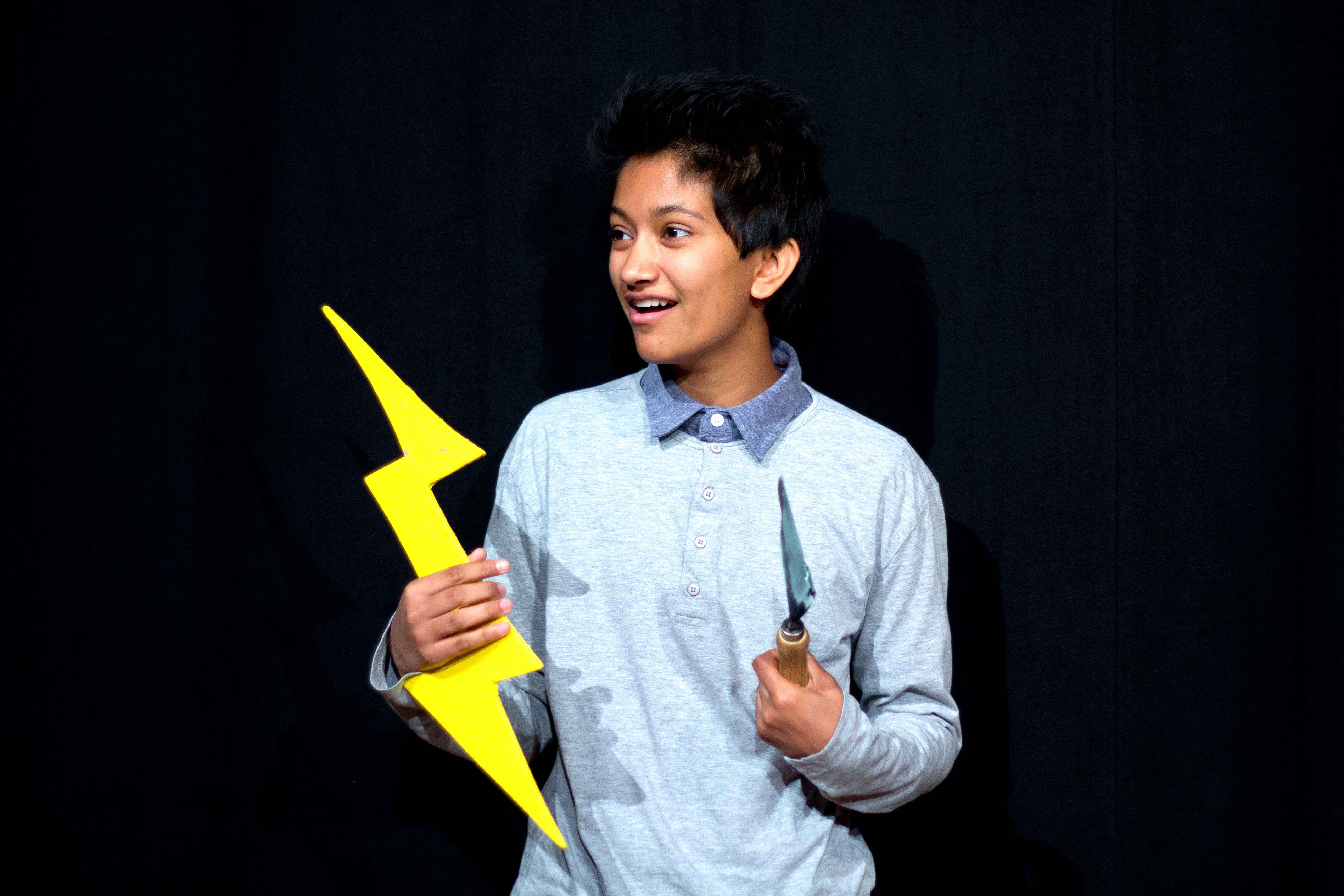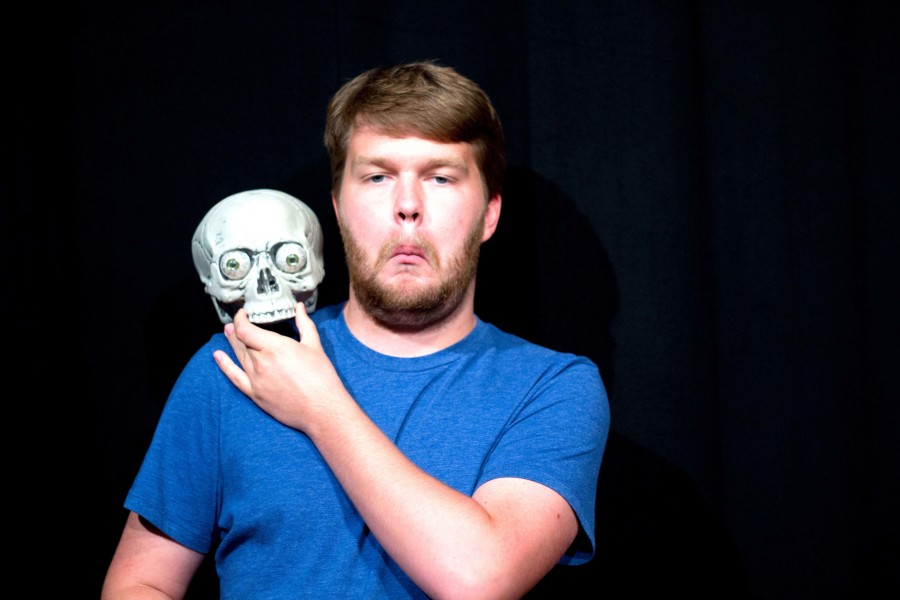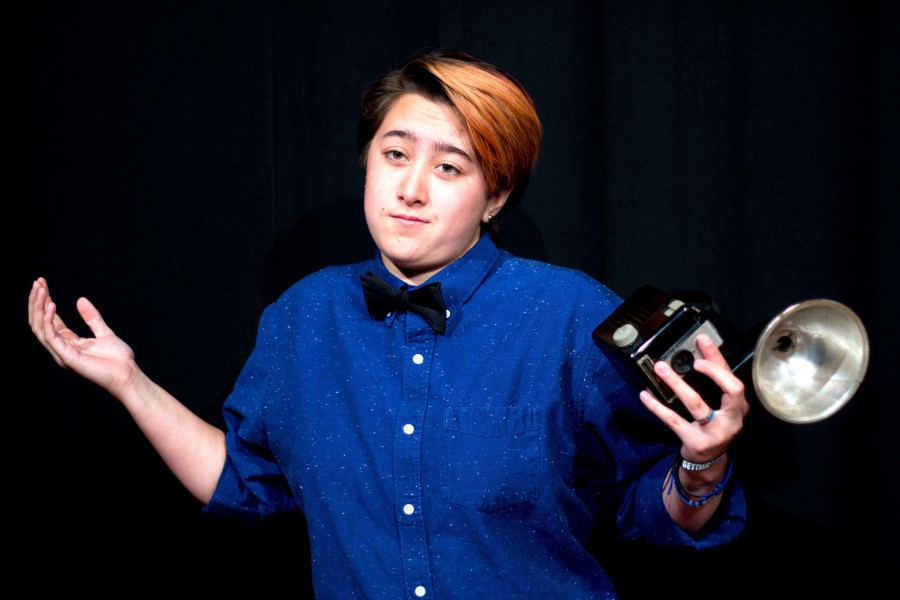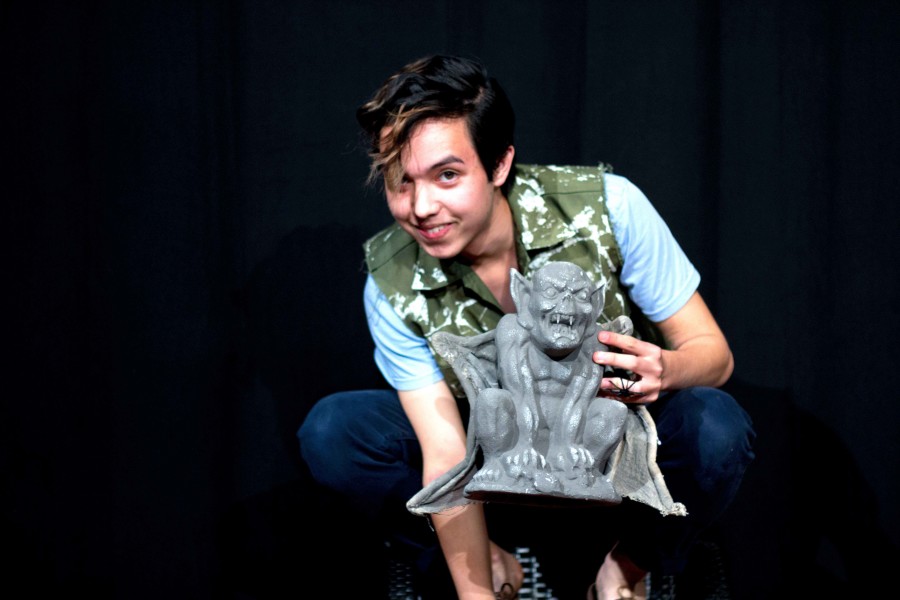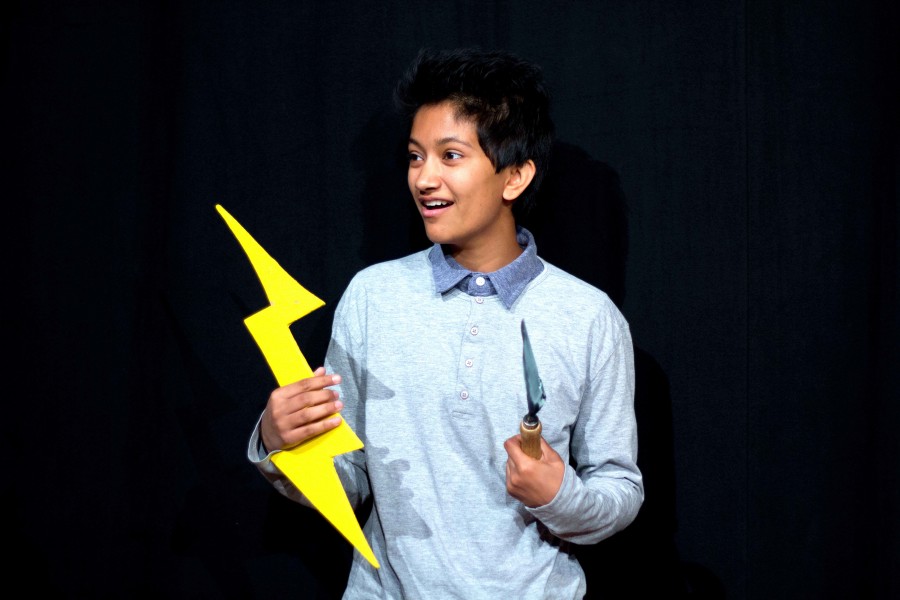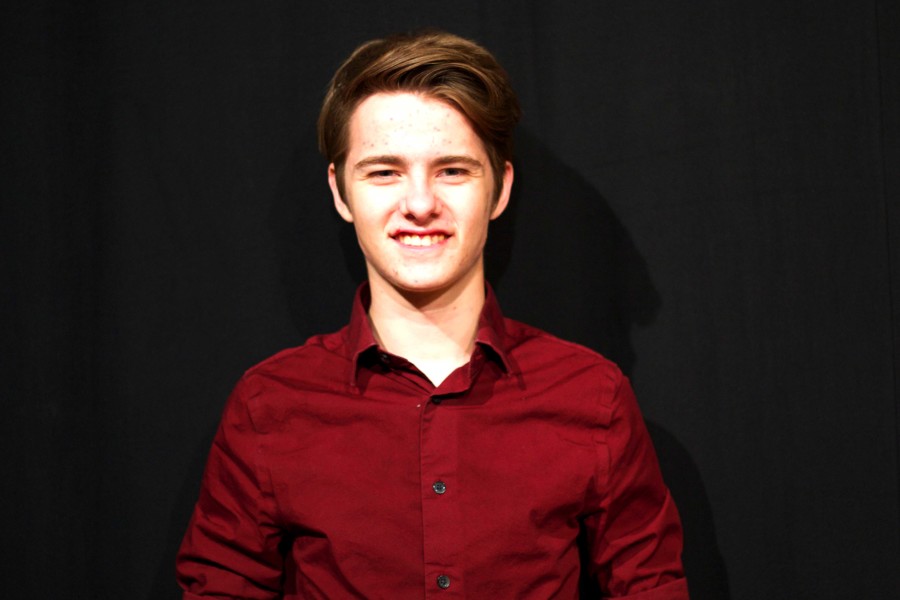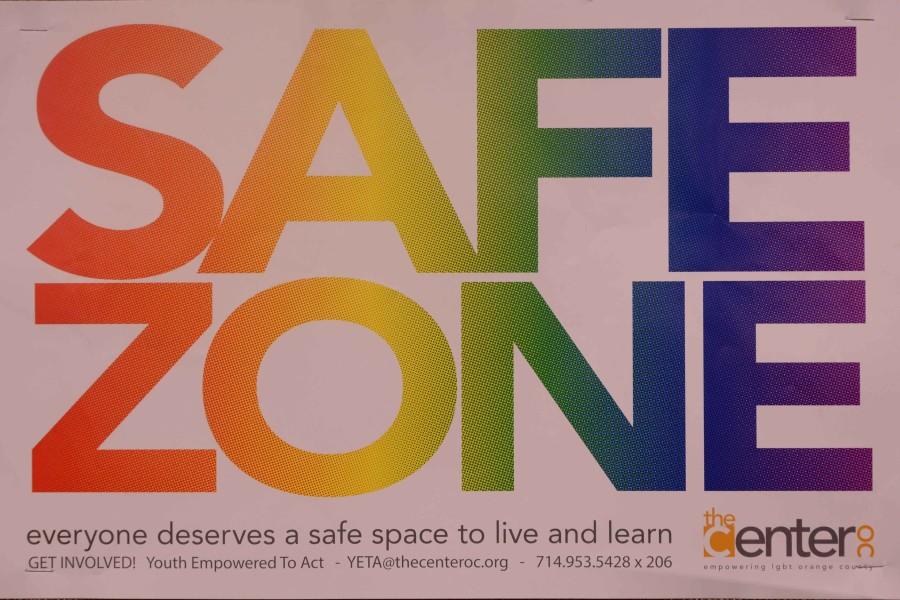Your donation will support the student journalists of San Juan Hills High School. Your contribution will allow us to cover our annual website hosting costs.
LGBTQ+
May 4, 2015
William Van Orsdel
Our world is not black and white and for William Van Orsdel (12), his sexuality isn’t either. Will’s sexual preference lies in the gray area as he is bisexual, or has a sexual and romantic interest in both men and women of varying or equal degrees.
When Will was a pre-teen, he began to notice that he was attracted to both boys and girls. According to our heteronormative culture, it is accepted for boys to be attracted to girls; however, Will noticed that he didn’t really have a problem with the way boys looked or the idea of dating boys either. When he thought about it, he found it was something that he would actually like.
Discovering his sexual orientation was a gradual process as Will did not come to terms with his identity until the end of his freshman year. He thought about his sexuality often and sought to discover what sexuality he would be able to identify with the most comfortably.
It only took basic sex education from Google for Will to discover that other sexualities exist for people who are not comfortable with strictly labeling themselves as straight or gay. In his research, he explored the bisexual orientation and accepted that he was bisexual.
Coming out to his family was positive experience for Will. He came out to his mother as bisexual over a private dinner. While she was confused, she was exceptionally supportive and accepted her son regardless of his sexual orientation.
Will came out to his brother and his brother responded with an open mind, revising his vocabulary and becoming more understanding of the LGBTQ+ community.
Lastly, Will came out to his father, the person who he was most apprehensive to confront. One day, as Will returned home from asking out his first boyfriend, his father greeted him, supportively questioning, “did he say yes?” William shares that since that moment, his father has been the most accommodating person in his family in regards to his sexual preferences.
Between 25-50% of homeless youth are a part of the LGBT+ community and are on the streets because of their sexual orientation or gender identity. Will’s coming out story is an example of a family who has accepted their child with open arms and provides hope for the future generation in learning to support their child, regardless of their sexuality.
After coming out, Will began to reflect upon our heteronormative society and discovered that the bisexual community is not responded to with as much hostility as the gay community as our culture assumes they just act like straight people.
On the contrary, Will also realized that a bias exists against the bisexual community as it is a common misconception that they need to “pick a side”––or associate themselves with either being gay or straight.
This is an ignorant conviction that our heteronormative culture has construed. Our society has a tendency to label sexuality in extremes; however, in order for people to understand bisexuality, it is necessary that they take a step back and accept that the world is not black and white and sexuality isn’t either.
“People automatically assume that bisexual people are more promiscuous and less faithful, which is frankly rather rude” said Will.
According to Will, the SJHHS Queer Alliance has provided students with “a place they can feel safe and be part of a community that cares about them, even when their households may not. It is also a great resource for students who just want to know more about sexuality and gender (especially given the rather abysmal state of American sex-ed).”
Sydney Tagle
When Sydney Tagle (10) was in middle school, the topic of homosexuality was discussed in her church. They concluded that same-sex relationships were a sin. As the topic was discussed further, Sydney began to question her own sexuality.
When she began to establish feelings towards other girls, she neglected them in fear of the deterioration of her relationship with the church that had always been the center of her life.
After discovering that she was not straight, Sydney sought relief from members of her church. She came out as bisexual to two of her Life Group leaders and a few close friends, but she was still confused and did not feel comfortable with this sexual identity.
As Sydney accepted that she was a lesbian, a sexual identity that she was able to appropriately identify with, she came out and experienced backlash. Her church community began to treat her differently and distanced themselves from her. Sydney took the initiative in an attempt to mend her compromised friendships as they had been some of the most important ones in her life. Her friends apologized and made their way back into her life.
Sydney grew up very involved in the church and felt most connected through her service in leadership and music. After it became known that she was a lesbian, the church created a rule that no members in the serving ministries would be able to be in a same sex relationship. Sydney was put on a long break, leaving her confused with her personal relationship with God.
The leadership team of her church has made it clear to Sydney that being in a same sex relationship dishonors God; therefore, Sydney is no longer able to be as involved in the church as she had previously been. The place in which she had grown up in and felt at home suddenly became a place where she received judgement for being herself.
Although she has been distanced from the church, Sydney’s relationship with her religious community has greatly improved.
She admits that it is difficult for her to understand the consequences that the Bible states for being in a same sex relationship. “The Bible states that being in a same sex relationship is a sin and I am scared knowing that I might be going to hell because of it but I don’t understand why. I am not hurting or affecting anyone else and, in my eyes, anyone should be able to love anyone they want.”
Sydney came out to her parents the beginning of her sophomore year. Her parents are not homophobic, but they don’t necessarily agree with her lifestyle.
It was hard for her to come out to her religious parents as she was unsure of what their response would be. Regardless of her sexual orientation, her mom still makes it a point to take Sydney to church every Sunday; however, her mother is supportive of her daughter as she makes an effort to understand and learn about Sydney’s sexual identification.
At school, teachers treat Sydney the same as any other student; however, when she notices other LGBTQ+ students receiving harsh treatment on campus, it is easy for her to identify with them as she experienced a similar struggle at her church. Sydney always stands up for what is right and for those who are on the receiving end of mistreatment.
Sydney is a member of the SJHHS Queer Alliance. Although her mother was apprehensive about her joining, the club has allowed Sydney to learn more about the LGBTQ+ community and has taught her that being comfortable with herself is important.
When Sydney began dating, she did not want to show any PDA at school because she was afraid of the reactions of her peers. Now, she is more comfortable with being affectionate with her girlfriend at school and she is going to continue doing what makes her happy.
Sydney stresses the importance of accepting yourself because in high school, people are going to judge you no matter what. Being comfortable with yourself is vital to your happiness.
“When you’re in the closet, you become shy and scared. But when you come out, you will begin to see the world in a different light,” said Tagle.
Sydney had always thought she would make her impact on others by playing music at church, but now she realizes now that God put her here in order to support and inspire those who are forced to endure similar struggles.
Kenley Farace
Imagine growing up, feeling like you were someone who was not the person they were raised to be, being someone with no cultural identity that you are able to connect with, and living in the world with a big question mark floating above your head.
This is the world Kenley Farace (12) has grown up in.
Kenley associates as a non-binary queer, adopts the pronouns they, them, and theirs.
Although Kenley may present themselves as masculine in appearance with a five o’clock shadow and a flannel button down, they do not associate as a male, nor do they associate with the cultural identity of a gay man; although they are attracted to masculinity. They don’t even associate as female. Kenley is all and none, best described as non-binary; associating as neither male, nor female.
“Queer” is a significant word for Kenley. The term has been used as a derogatory slur in the past; however, it has been reclaimed by the LGBTQ+ community as a term referring to gender and sexuality minorities; people who are not straight or cisgender. Kenley, in turn, identifies their sexuality as queer and does not identify with the gender assigned to them at birth.
Kenley first realized they were different than the majority of students in their middle school around the age of twelve. Around this time, many kids find that their sexual feelings begin to develop but Kenley was not attracted to girls in the same way the other boys were. Kenley rather found that they were attracted to boys, or masculinity. Although they never really felt secure in school, Kenley felt welcomed and received little, if any, adversity coming out as gay. Their family was very accepting and happy for them. Kenley felt as if they had found some identity for themselves, however, this identity was not the one they could settle in.
After coming out, Kenley noticed a difference between themselves and the cultural connotation of gay culture. Kenley felt insecure in the fact that they did not fill any role given to them by society. Feeling one way and desiring to be another, Kenley went through a phase of “purging the femininity” out of their life. Striving to be masculine, they listened to angry music and hoped they would fill the blank space in their “hello my name is” tag.
During their freshman year, Kenley went through a “bowtie phase” in an attempt to convey their masculinity through a less hyper-masculine medium.
In between their freshman and sophomore year, Kenley attended a queer leadership camp through the Gay-Straight Alliance (GSA) Network and met a group of non-binary people. This is where they were first introduced to the idea of being non-binary. It was not until their junior year that the connection was made and the blank space filled.
It was after coming out as Non-Binary that Kenley finally felt comfortable and their emotions seemed to settle. Their style moved away from hyper-masculinity, an attempt at concealing their insecurities, to a more relaxed “wear whatever” approach. With newfound identity, Kenley felt they could move on and live their life as their own self.
As the president of the Queer Alliance club at SJHHS, with very strong beliefs in queer culture and rights, Kenley hopes that there will be more representation of queers, on and off campus. They also hope that their story provides the proof that non-binary people exist, that it is not uncommon, and that their peers recognize it as a respective gender identity.
Siddharth Piravi
Siddharth Piravi (9) was assigned female at birth.
In February of his eighth grade year, Sid accepted that he was transgender. Transgender is an umbrella term for people who feel that the gender they associate with is different from the one that they have been assigned at birth. This feeling is independent from any medical or hormonal transition.
Growing up, he shopped in the boy’s section, cut his hair short, and it was accepted that Sid was just a tomboy. As children, we do not see gender and we do not become a victim to gender roles but as we grow up, we begin to pay attention to social norms and acceptable behaviors based upon our biological gender.
In middle school, it was not okay for Sid to be the tomboy he always had been as gender roles began to define his being. Up until age 11, gender roles didn’t matter to Sid but once society told him that they did, he was forced to wear dresses, grow out his hair, and begin to wear makeup in an attempt to fit in with the stereotype of a girl that he had never been able to identify with.
In December of his eighth grade year, Sid came out to his family and close friends as a lesbian. Belonging to a conservative group of friends at the time, Sid lost a lot of people who mattered to him. The reaction of his friends sparked a basic lack of trust in Sid, causing him to distance himself and to alter the way in which he maintains relationships.
Even after his initial coming out, Sid still felt uneasy with his identity. Throughout his eighth grade year, Sid became increasingly social and began to make more experiences for himself; however, as a girl, Sid grew depressed as he was never able to enjoy the experiences that he was having.
In the two years that Sid made an attempt to conform to society and be a girl, he tried lead a happy life but it was nearly impossible as he was at a constant war with himself. This experiment was necessary for Sid to realize that he was not a girl.
Throughout this period of his life, Sid was reminded of his childhood days in which society had accepted him as a tomboy and how it had been so easy for him to identify with the boys. It was clear that Sid did not associate with being female, but he did not know how he could act upon these emotions. At this time, Sid didn’t even know that it was possible to be transgender.
As Sid would discover in the next couple months, his depression was triggered as a result of dysphoria, a condition of feeling as one’s gender identity is not consistent with their biological sex.
In order to understand the complexities of gender and discover what action he could take in securing his gender identity, Sid began to participate in a great deal of research. Throughout his investigation, he realized that he had never been a girl and once he came to his conclusion, he could not ignore the discomfort he felt with his assigned sex.
Sid, along with 2-5% of the population was born with strong, persistent feelings of identifications with the opposite gender and discomfort with one’s own assigned sex.
Gender is whatever you want it to be. It is whatever you self-identify as and it is unique for each individual. Everyone was assigned a sex at birth (male or female) based upon biological elements; however, whatever is outside of that assignment, whether it be consistent or inconsistent with one’s assigned sex is their gender. Society has created a large difference between men and women, forcing strict gender roles; however, gender has the ability to be flexible. Gender is nothing more than a social construct.
“Sex is your anatomy and gender is whatever lies between your ears” said Piravi.
Sid admits that he is a feminine boy as he cares a lot about his appearance and can be extremely flamboyant at times but this is just the way he is and it has no reflection on his manliness––it doesn’t make him any less of a boy.
In order to come to terms with his gender confusion, he was forced to mature quickly. The majority of the transgender community has their realization and accepts it much later in their lives, but Sid knew that in order to be happy in the best years of his life, he must begin his transformation sooner rather than later.
Throughout the following months, Sid came out to his family and close friends. When Sid was born, his parents wrapped their “daughter” in a pink blanket so it is difficult for them to accept Sid as their son; however, they have nothing against his transformation. Although his family are liberal and supporters of the LGBT+ community, they do not completely understand the complexities of gender. Being homosexual is more common than being transgender, and while more people are supporting same sex marriage, there is still a lot to be learned about the complexities of gender.
The summer coming into his freshman year, Sid went to India with his family and was not able to tell any of his extended relatives that he was transgender because of India’s strictly conservative culture. As the rape capital of the world, Indian fathers are expected to protect their daughters at a young age so when born a girl in Indian culture, there is no question that that is your identity. Sid has still not come out to his family in India.
Sid returned from India that summer and began his freshman year of high school as a boy. Throughout his first month of high school, Sid learned that some of his simplest daily routines pre-transformation, such as using restrooms and taking attendance, were some of the hardest things to do as a as a transgender student.
The first day of school was uncomfortable for Sid as his teachers called roll for “Maya” and he had to correct his teachers in front of the whole class. A lot of people were curious and confronted Sid about why he had a girls’ name. He couldn’t avoid the question. He was also posed with a dilemma when he had to use the restroom. Because he does not possess the appropriate anatomy in order to use the boys’ restroom but his gender identity makes it uncomfortable for him to use the girls’ restroom, he is forced to use the restroom in the health office as there are no gender neutral bathrooms on campus.
Not only do transgender people have to fight a battle with their friends, family, and authority, but there is also a constant battle within their own minds and bodies such as dysphoria and depression that affects every aspect of their lives.
In order to combat his dysphoria, Sid makes conscious efforts in order to shield his femininity such as making his voice deeper, wearing multiple sports bras of a size too small for him to flatten his chest, as well as walking and dressing differently. When Sid shops, he is constantly aware of what he is able to wear in order to pass as a boy. The majority of his efforts are dedicated to his own happiness; however, it is also necessary that Sid makes these changes for others in an attempt to be perceived as the gender he identifies with.
Sid has not began any medicinal or hormonal transition as he is still a minor. While his parents support Sid in all his endeavors, they are cautious in terms of his physical transformation as they want to make sure that he knows what he wants.
In the future, Sid wants to start taking blockers which will prevent female hormones from developing further and testosterone, the male hormone, in order to begin his female-to-male (FTM) physical transformation so that his biological sex will become more consistent with his perceived gender and his external and internal being are able to comfortably coexist. He wants to have top surgery and wishes to be an advocate for the transgender community.
“I want to have the body I deserve” said Piravi.
Sid wants to be treated as you would treat any other male because he is a normal boy––he just got started on the wrong track.
Pierce Livingston
Pierce Livingston (12) began to realize that he was gay in middle school. For a while, he tried to hide it from himself and attempted to convince himself that he was attracted to girls in order to cover up the feelings he was having for other boys.
He tried to tell himself that he was bisexual. In his head, being bisexual was more “normal” than being gay, since he was “still into girls,” even though he could no longer deny that had feelings for boys. However, in the back of his mind he knew that he was not bisexual. He was gay.
Once accepting that he was gay, he realized there was nothing he could do about it. At first, it felt like it was a fault of his, or a personality flaw. Society pressures boys to like girls and girls to like boys. Pierce would always be asked if he had a girlfriend during family get-togethers, but they would never ask if he had a boyfriend.
Queer people often have a hard time feeling “normal” because from their youth it is imprinted into their brains that relationships should be between men and women. This phenomenon is known as heteronormativity, which is the idea that society normalizes heterosexual behaviors, attitudes, and gender roles. Anything that doesn’t fit into these heterosexual categories is looked down upon or thought of as wrong. This attitude is damaging to queer people because it can make them feel as if their differences are inferiorities.
One of the ways Pierce tried to “normalize” himself, even after he came out to people, was by trying to separate himself from stereotypical gay people.
This is called internalized homophobia. Even though he was gay, it was difficult for him to truly accept himself and accept others because of society’s influence to pressure him, as a male, against homosexuality and femininity. Pierce tried very hard not to be the stereotypical gay man. He would purposefully act less flamboyant, trying to make the fact that he was gay a less noticeable characteristic about himself.
This unhealthy attitude contributed to his harmful mentality that there is something wrong with being more flamboyant or feminine, and he distanced him from the queer community.
Coming out brought different reactions from different groups of people.
Coming out to his parents was different than coming out to his friends. His parents have always been very liberal and supportive of him and his siblings.
Pierce told his family that he was going on a date with a girl, when he was really going out with another boy. He then told them that it would be a double date with another couple, when it would really just be him and the one boy. His parents saw him on the date, and when asked where the girls were, he tried to cover it up and said that they, “didn’t show up”. Later, his parents asked him if he was gay and he said yes.
The main concern that Pierce had with telling his family was he thought they would be disappointed in him for not being able to raise a family the traditional, heterosexual way. Notice the word used was “traditional” and not “normal”. The general attitude that the heterosexual way of raising a family is the “right” or “normal” way is a huge issue that the LGBT+ community is trying to change.
It is a common misconception that coming out consists of just a few conversations with close family and friends. However, according to Pierce, “coming out is constant, and you’re always dealing with it.” He is constantly coming out to new friends, classmates, and fellow actors. He is generally pretty open about his sexuality. “If someone asks me about it, I’m going to be honest with them unless I think it’s going to cause me physical harm,” says Pierce.
For the most part, dealing with someone who has not been welcoming of Pierce’s sexuality has not been a great struggle. “If someone is not okay with me being gay, then I just don’t talk to them,” he says. However, dealing with people who he has to see every day, namely teachers and classmates, has been significantly more difficult.
Pierce is extremely comfortable with who he is now. As an active member of the Queer Alliance club at SJHHS, he would consider himself “out”.
However, he says he is technically still “in the closet” to certain people. He consciously acts less flamboyant in his academic classes, around certain people, and even with his friends. Even though he is proud of who he is, he says that if he had a boyfriend at school, he would not be public about that relationship whatsoever because he always needs to be cautious and fearful of his safety. Pierce would not feel comfortable holding hands with his boyfriend publically because there’s a fear within him that he will get physically or verbally abused if he were to be public about his relationships.
He is exceptionally affected by the word faggot. Walk through any high school campus, and you are bound to overhear the word at least a few times. Whether it be friends teasing each other, students slamming their homosexual classmate behind their back, the word is extremely derogatory.
Throughout history, homophobes would burn queer people while they were tied to bundles of sticks, and that is where the term came from. When Pierce hears the word being loosely thrown around, he doesn’t think it’s a funny way of joking with a friend. He thinks about the years of torture and discrimination that queer people have received for trying to being who they are.
Pierce has overcome many struggles with his sexuality, but “its not all dark and depressing,” he says. Discovering his sexuality has allowed him to discover many things about himself and he has been inspired to make a difference.
AB 1266 Law Prevents Discrimination at SJHHS
AB 1266: Existing law prohibits public schools from discriminating on the basis of specified characteristics, including gender, gender identity, and gender expression, and specifies various statements of legislative intent and the policies of the state in that regard. Existing law requires that participation in a particular physical education activity or sport, if required of pupils of one sex, be available to pupils of each sex.
This bill requires that a pupil be permitted to participate in sex-segregated school programs and activities, including athletic teams and competitions while also allowing the use of facilities consistent with their gender identity, irrespective of the gender listed on the pupil’s records.
This law will allow students to use the restroom that they most align with their gender identity, as well as allowing students to change their name and pronoun on documents such as attendance records, so that teachers do not misgender them.
There were two PTSA meetings regarding LGBTQ+ rights. One was for LGBTQ+ rights in general and pertained to CUSD as a whole. The other one, which took place on April 1st, was for SJHHS specifically, with a primary focus on AB 1266 and an update of nondiscrimination policy.
Tom Ressler, current principal at SJHHS, attended one of the meetings. Ressler stated that the PTSA’s focus differs on the perceived importance of an issue.
“There are different things they (PTSA) take as being important issues for students and for schools so they will go and advocate certain positions. This was one of the issues that the California PTSA wanted to support so they put some resolution together,” said Ressler.
The state PTSA has adopted a resolution that they want to present to the state which says that they support the nondiscrimination policy. School boards around the state are starting to adopt. This was brought up at the Capistrano Unified Council of PTSAs.
Even though there was a majority support for the implementation of AB 1266, the PTSA’s approval on the law ultimately does not matter.
“AB 1266 is the law so it doesn’t matter who doesn’t like it. It is just a matter of how were going to implement this law,” said Ressler.
Mrs. Serio, English teacher and the adviser of the Queer Alliance Club at SJHHS, attended the meeting to gauge parent support and to provide information for AB 1266. Serio attended the PTSA meeting that took place on April 1st.
She noted there was a majority support for the implementation of AB 1266.
The main purpose of the law is to make students feel more comfortable and safe. It also creates a new mandate where transgender students can change the listing of their gender in the district without parental approval.
“I specifically think about how my students are going to feel safer and happier at school and what I can do to make those students feel valued and important,” said Serio.
The Queer Alliance Club is focused on making a safe space for the youth of SJHHS and they are also working with the school district to implement the law.
“We’re working with the school district regarding AB 1266 which is a law in California to promote a safe place for transgenders,” said Kenley Farace.
Students involved in the QA club are looking forward to the implementation of the law; sooner rather than later.
“I really hope that this law can be implemented before I graduate. It will be a great milestone for the LGBTQ+ community at our school and will make kids feel safe on campus.” said Sid Piravi (9).
The law ultimately stands to create a safe learning environment for every single student.
“The thing that’s important for me at the school site is that we want to make sure we do everything we possibly can to let all of our students feel safe and respected, that’s the bottom line. It’s not about bathrooms, it’s not about locker rooms, it’s letting kids feel safe,” said Ressler.
Queer Alliance Club Aims to Help Students Feel Safer and Reduce Peer Discrimination
SJHHS has a plethora of these posters plastered on classroom windows, illustrating to all students that they have a safe place at school and with their teachers.
Queer Alliance is a club that was created by Kenley Farace (12) and Alison Galvin (12) that focuses on establishing a safe space for queer youth at SJHHS.
The club is creating a “support system for queer people with other queer people and straight people can be apart of it too, that’s totally fine. But it’s just not about them because they don’t have to struggle with their gender identity or their orientation because society already accepts them for who they are in those regards,” says Pierce Livingston.
The club is called Queer Alliance for two main reasons: ¨number one, when it’s just gay-straight alliance, it is exclusionary of transgender people and bisexual people because they are not in the name. Furthermore, gay-straight alliance’s intention was to have this bridge of communities between gay people and straight people but that’s not really what we’re trying to do with Queer Alliance,” says Livingston (12).
In regards to why they chose the word “queer” in their club name, Livingston says,
“Queer is kind of a reclaimed slur within the community. So, while originally it was not an okay thing to say because it was used derogatorily, queer people have reclaimed it as an umbrella term for people under different gender identities or sexual orientations that aren’t straight or transgender.”
Although some are offended by the word “queer,¨ Livingston believes that for the sake of being all-encompassing toward people of various gender identities and sexual orientations, it is the best term to use for the club.
The club is currently promoting equality by establishing a button campaign in which they have purchased buttons that say, “He/Him/His, She/He/Hers, They/Them/Theirs.¨ This is to normalize asking people about their pronouns rather than assuming their gender based on their appearance.
Queer Alliance was given “Safe Zone” posters by the Center OC — an LGBTQ+ organization that supports equality for all gender identities and sexual orientations — to hand out to the administration and staff of SJHHS.
“The Safe Zone posters are just there to let queer students know that at school we are trying to support being a place where they can feel safe to be themselves and not be persecuted or discriminated against for their gender identity or sexual orientation,” says Livingston.
“The context is that it is for queer people but I also think that it’s general and it applies to everyone because we can’t just talk about queer oppression. Bullying in general should not be tolerated,” says Farace.
Occasionally the club will have powerpoints or lectures where they explain concepts and terms to those who may not understand them.
“It’s just a good place to ask questions, like if you’re confused about something, or if you just generally want support or someone to talk to, or you just want to hangout with fun people,” says Livingston.
“I would go to queer alliance because they are a good support system and you can learn all there but pretty much talk to someone if you’re very confused or even if you’re just questioning talk to someone,” said Sydney Tagle (10).
“The meetings are probably the best way to get involved. At the meetings we kind of just hangout and talk about what we are doing, what we are doing to move forward, and any events we have planned.¨
“Come to Queer Alliance. I said that we build it around queer youth but our straight friends are always welcome. Just be there and listen,” says Farace.
Pronouns: What You Call Someone Matters
“Hi, my name is Connor. My favorite food is spaghetti and I go by he/him/his pronouns.”
Simply adding this last phrase about preferred pronouns is the start of a new introductory saying. The majority of people are not accustomed to asking for preferred pronouns, or even stating their own. Members of the LGBTQ+ community wish to normalize this act of courtesy in order to prevent people from feeling uncomfortable.
Amalia Priest (12) says, “asking for everyone’s pronouns is very important and crucial, as to not single anyone out. If you ask one individual for their pronouns just because you are unsure of their identity, it brings up a weird [vibe into the conversation], instead you should treat everyone similarly when asking for pronouns.”
Because asking for pronouns is not yet normalized, using their name in place of a pronoun is ideal until the appropriate time to ask for their pronouns comes up.
It allows a person to make the choice of deciding what they feel comfortable being identified as. Many believe that you are either a man or a woman, but there are many possibilities; male, female, all gender, gender neutral, gender queer, nonbinary, as well as gender-fluid.
It is highly disrespectful to refer to transgender or gender nonconforming students by using the incorrect pronouns, and it can often make them feel uncomfortable because they are being referred to as something they have no identification with.
Imagine meeting someone for the first time, and before you have the chance to introduce yourself they call you by the wrong name. This would confuse you or even offend you because they did not take into consideration what you want to be called.
This concept applies to pronouns as they should not be simply based off of appearance since= it can cause people to feel uneasy. Priest said, “It’s dysphoric when people don’t see you as you see yourself.”
“People should act toward you based on your gender, not your sex,” says Sid Piravi regarding gender pronouns. Sex is what biological parts someone is born with, gender is what people choose to identify whether it matches or not with the sex they were born with.
Gender does not mean sex, according to an article in the CSM. Skylar Crownover was accepted into an all girl school without identifying with girl as her gender sophomore in college, and often gets asked how this was possible. Crownover said, “I just tell them the application asks you to mark your sex and I did. It didn’t ask me for my gender.”
“Gender is often assigned at birth, a system we’re starting to take down,” states Kenley Farace, (12). While some people may be confused about the gender neutral term “they” for a single person Kenley explains it as “When you’re driving, and someone cuts in front of you, you dont say “oh, he/she cut me off, you say “they” cut me off.
People use singular form of they them all the time without even realizing it.” They/them/theirs is accepted as a gender neutral pronoun. Therefore a lot of non-binary people use it. Within the Oxford Dictionary website, it recently updated to include they, them, themselves as singular pronouns.
“When people understand that both genders are equal, they will also understand that there are more than two genders. When gender equality is reached, I believe that people will understand that your gender can be different from your sex” says Sid Piravi.
